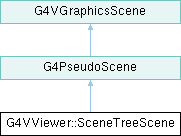Loading...
Searching...
No Matches
G4VViewer::SceneTreeScene Class Reference
#include <G4VViewer.hh>
 Inheritance diagram for G4VViewer::SceneTreeScene:
Inheritance diagram for G4VViewer::SceneTreeScene:Public Member Functions | |
| SceneTreeScene ()=default | |
| ~SceneTreeScene ()=default | |
| void | SetViewer (G4VViewer *pViewer) |
| void | SetModel (G4VModel *pModel) |
 Public Member Functions inherited from G4PseudoScene Public Member Functions inherited from G4PseudoScene | |
| G4PseudoScene ()=default | |
| virtual | ~G4PseudoScene ()=default |
| void | PreAddSolid (const G4Transform3D &objectTransformation, const G4VisAttributes &visAttributes) |
| void | PostAddSolid () |
| void | AddSolid (const G4Box &solid) |
| void | AddSolid (const G4Cons &solid) |
| void | AddSolid (const G4Orb &solid) |
| void | AddSolid (const G4Para &solid) |
| void | AddSolid (const G4Sphere &solid) |
| void | AddSolid (const G4Torus &solid) |
| void | AddSolid (const G4Trap &solid) |
| void | AddSolid (const G4Trd &solid) |
| void | AddSolid (const G4Tubs &solid) |
| void | AddSolid (const G4Ellipsoid &solid) |
| void | AddSolid (const G4Polycone &solid) |
| void | AddSolid (const G4Polyhedra &solid) |
| void | AddSolid (const G4TessellatedSolid &solid) |
| void | AddSolid (const G4VSolid &solid) |
| void | AddCompound (const G4VTrajectory &) |
| void | AddCompound (const G4VHit &) |
| void | AddCompound (const G4VDigi &) |
| void | AddCompound (const G4THitsMap< G4double > &) |
| void | AddCompound (const G4THitsMap< G4StatDouble > &) |
| void | AddCompound (const G4Mesh &) |
| void | BeginPrimitives (const G4Transform3D &) |
| void | EndPrimitives () |
| void | BeginPrimitives2D (const G4Transform3D &) |
| void | EndPrimitives2D () |
| void | AddPrimitive (const G4Polyline &) |
| void | AddPrimitive (const G4Text &) |
| void | AddPrimitive (const G4Circle &) |
| void | AddPrimitive (const G4Square &) |
| void | AddPrimitive (const G4Polymarker &) |
| void | AddPrimitive (const G4Polyhedron &) |
| void | AddPrimitive (const G4Plotter &) |
 Public Member Functions inherited from G4VGraphicsScene Public Member Functions inherited from G4VGraphicsScene | |
| G4VGraphicsScene () | |
| virtual | ~G4VGraphicsScene () |
| virtual const G4VisExtent & | GetExtent () const |
Additional Inherited Members | |
 Protected Member Functions inherited from G4PseudoScene Protected Member Functions inherited from G4PseudoScene | |
 Protected Attributes inherited from G4PseudoScene Protected Attributes inherited from G4PseudoScene | |
| const G4Transform3D * | fpCurrentObjectTransformation = nullptr |
| const G4VisAttributes * | fpVisAttributes = nullptr |
Detailed Description
- The scene tree is a tree of G4SceneTreeItem objects (see graphics-reps).
- Its root is a data member fSceneTree of all viewers by virtue of G4VViewer inheritance,
- G4SceneTreeItem is an aggregate of data members that represent properties of objects in the scene (G4Scene). Its data members are low-level types - G4String, G4VisAttributes and G4AttDef/Value - so that it can be used across categories, avoiding coupling.
- The root item has children that represent the models (G4VModel sub-classes) in the scene.
- For a G4PhysicalVolumeModel (detector components), its children and children's children, etc., imitate the geometry hierarchy of that model. These descendants are called "touchables".
- There may be more than one G4PhysicalVolumeModel, depending how the user creates his/her scene.
- The scene tree is reviewed, and updated if necessary, at every pass of G4VSceneHandler::ProcessScene. This is called a "kernel visit".
- A kernel visit is triggered by some vis commands (e.g., /vis/viewer/rebuild) and by a viewer if it deems necessary. For example, a kernel visit may not be required for a rotation, zoom, etc., but required for a change from surface to wireframe.
- The idea is that the scene tree can be passed to a GUI, the GUI can create a tree widget, and interactions with it raise UI commands such as /vis/scene/activateModel, /vis/set/touchable and /vis/touchable/set/... The viewer decides if this requires a kernel visit, otherwise it must update fSceneTree itself (utilities are provided - G4VViewer::TouchableSetVisibility/Colour).
Definition at line 171 of file G4VViewer.hh.
Constructor & Destructor Documentation
◆ SceneTreeScene()
|
default |
◆ ~SceneTreeScene()
|
default |
Member Function Documentation
◆ SetModel()
| void G4VViewer::SceneTreeScene::SetModel | ( | G4VModel * | pModel | ) |
Definition at line 234 of file G4VViewer.cc.
235{
236 fpModel = pModel;
237
238 // Insert in tree (if not already inserted)
241 FindOrInsertModel(modelType, modelID);
242
244 if (pvModel) {
245 // Limit the expanded depth to limit the number expanded so as not to swamp the GUI
246 G4int expanded = 0;
247 for (const auto& dn : pvModel->GetNumberOfTouchables()) {
248 expanded += dn.second;
249 if (fMaximumExpandedDepth < dn.first) fMaximumExpandedDepth = dn.first;
250 if (expanded > fMaximumExpanded) break;
251 }
252 }
253}
const G4String & GetGlobalDescription() const
const G4String & GetType() const
◆ SetViewer()
|
inline |
Definition at line 176 of file G4VViewer.hh.
176{fpViewer = pViewer;}
Referenced by G4VSceneHandler::DrawEndOfRunModels(), G4VSceneHandler::DrawEvent(), and G4VSceneHandler::ProcessScene().
The documentation for this class was generated from the following files:
